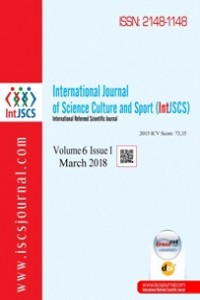Öz
Kaynakça
- Csikszentmihalyi M (1975). Beyond Boredom and Anxiety. San Francisco: Jossey-Bass.
- Csikszentmihalyi M (1990). Flow: The Psychology of Optimal Experience. New York: Harper & Row.
- Jackson SA (1992). Athletes in Flow: A Qualitative Investigation of Flow States in Elite Figure Skaters. Journal of Applied Sport Psychology, 4(2), 161–180.
- Jackson SA (1995). Factors Influencing the Occurrence of Flow in Elite Athletes. Journal of Applied Sport Psychology, 7(2), 138-166.
- Jackson SA (1996). Toward a Conceptual Understanding of the Flow Experience in Elite Athletes. Research Quarterly for Exercise and Sport, 67(1), 76-90.
- Jackson SA, Csikszentmihalyi M (1999). Flow in Sports. Champaign, IL: Human Kinetics.
- Jackson SA, Eklund RC (2004). The Flow Scales Manual. Morgantown, WV: Fitness Information Technology.
- Jackson SA, Marsh HW (1996). Development and Validation of a Scale to Measure Optimal Experience: The Flow State Scale. Journal of Sport & Exercise Psychology, 18, 17-35.
- Jackson SA, Roberts GC (1992). Positive Performance States of Athletes: Toward a Conceptual Understanding of Peak Performance. The Sport Psychologist, 6(2), 156-171.
- Jackson SA, Kimiecik JC, Ford S, Marsh HW (1998). Psychological Correlates of Flow in Sport. Journal of Sport & Exercise Psychology, 20(4), 358-378.
- Jackson SA, Kimiecik JC, Ford S, Marsh HW (1998). Psychological Correlates of Flow in Sport. Journal of Sport & Exercise Psychology, 20(4), 358-378.
- Kimieick JC, Stein GL (1992). Examining Flow Experiences in Sport Contexts: Conceptual Issues and Methodological Concerns. Journal of Applied Sport Psychology, 4(2), 144-160.
- McInman AD, Grove JR (1991). Peak Moments in Sport: A Literature Review. Quest, 43, 333-351.
- Ryan RM, Frederick CM, Lepes D, Rubio N, Sheldon KM (1997). Intrinsic Motivation and Exercise Adherence. International Journal of Sport Psychology, 28(4), 335-354.
- Sugiyama T, Inomata K (2005). Qualitative Examination of Flow Experience among Top Japanese Athletes. Perceptual and Motor Skills, 100(3), 969-982.
- Young JA (2000). Professional Tennis Players in the Zone. In S. J. Haake and A. Coe (Eds.), Tennis Science & Technology, 417-422.
Dispositional Flow State among Open Skill Athletes: A Predictor and Quantification of Sport Performance
Öz
The present study was
aimed to identify the role of Dispositional Flow Scale-2 (DFS-2) among open
skill athletes. In order to achieve the objective of the study, Sixty (N=60)
male university level open skill athletes of 19 to 25 years of age were
selected to act as a subject. A prior
consent was sought from all the subjects after being informed about the
objective and protocol of a study. The sixty (N=60) subjects were segregated
into three groups i.e. N1= 20
Basketball, N2=20
Handball, N3=20
Football. To measure the level of Flow of the subjects, the Dispositional Flow
Scale-2 (DFS-2) Questionnaire constructed by Jackson and Eklund (2004) was
administered. One way Analysis of Variance (ANOVA) was employed to compare
various sports groups i.e. open skill athletes. Where ‘F’ values were found
significant, LSD (Least Significant Difference) Post-hoc test was applied to
find out the direction and degree of differences. For testing the hypothesis,
the level of significance was set at 0.05. Significant differences were found
among various sport groups (basketball,
handball, and football) on the
sub-variables of DFS-2 i.e. unambiguous feedback, sense of control, loss of
self-consciousness and overall dispositional flow scale-2. However, no
significant differences were found on the sub-variables of DFS-2 i.e. challenge-skill balance, action-awareness
merging, clear goals, concentration on the task at hand, transformation of time and autotelic
experience.
Anahtar Kelimeler
Dispositional Flow Scale-2 (DFS-2) Open Skill Athletes Performance
Kaynakça
- Csikszentmihalyi M (1975). Beyond Boredom and Anxiety. San Francisco: Jossey-Bass.
- Csikszentmihalyi M (1990). Flow: The Psychology of Optimal Experience. New York: Harper & Row.
- Jackson SA (1992). Athletes in Flow: A Qualitative Investigation of Flow States in Elite Figure Skaters. Journal of Applied Sport Psychology, 4(2), 161–180.
- Jackson SA (1995). Factors Influencing the Occurrence of Flow in Elite Athletes. Journal of Applied Sport Psychology, 7(2), 138-166.
- Jackson SA (1996). Toward a Conceptual Understanding of the Flow Experience in Elite Athletes. Research Quarterly for Exercise and Sport, 67(1), 76-90.
- Jackson SA, Csikszentmihalyi M (1999). Flow in Sports. Champaign, IL: Human Kinetics.
- Jackson SA, Eklund RC (2004). The Flow Scales Manual. Morgantown, WV: Fitness Information Technology.
- Jackson SA, Marsh HW (1996). Development and Validation of a Scale to Measure Optimal Experience: The Flow State Scale. Journal of Sport & Exercise Psychology, 18, 17-35.
- Jackson SA, Roberts GC (1992). Positive Performance States of Athletes: Toward a Conceptual Understanding of Peak Performance. The Sport Psychologist, 6(2), 156-171.
- Jackson SA, Kimiecik JC, Ford S, Marsh HW (1998). Psychological Correlates of Flow in Sport. Journal of Sport & Exercise Psychology, 20(4), 358-378.
- Jackson SA, Kimiecik JC, Ford S, Marsh HW (1998). Psychological Correlates of Flow in Sport. Journal of Sport & Exercise Psychology, 20(4), 358-378.
- Kimieick JC, Stein GL (1992). Examining Flow Experiences in Sport Contexts: Conceptual Issues and Methodological Concerns. Journal of Applied Sport Psychology, 4(2), 144-160.
- McInman AD, Grove JR (1991). Peak Moments in Sport: A Literature Review. Quest, 43, 333-351.
- Ryan RM, Frederick CM, Lepes D, Rubio N, Sheldon KM (1997). Intrinsic Motivation and Exercise Adherence. International Journal of Sport Psychology, 28(4), 335-354.
- Sugiyama T, Inomata K (2005). Qualitative Examination of Flow Experience among Top Japanese Athletes. Perceptual and Motor Skills, 100(3), 969-982.
- Young JA (2000). Professional Tennis Players in the Zone. In S. J. Haake and A. Coe (Eds.), Tennis Science & Technology, 417-422.
Ayrıntılar
| Birincil Dil | İngilizce |
|---|---|
| Konular | Spor Hekimliği |
| Bölüm | Makaleler |
| Yazarlar | |
| Yayımlanma Tarihi | 30 Mart 2018 |
| Yayımlandığı Sayı | Yıl 2018 Cilt: 6 Sayı: 1 |

